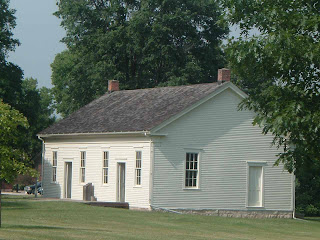 I love lily of the valley plants. And, the smell! It is absolutely wonderful. I don't think I'll ever be able to afford them, but several big designers use the lily of the valley scent as their base for their brand perfumes. If you recognize the smell, you know what I mean. (At least, I think most people love it!)
I love lily of the valley plants. And, the smell! It is absolutely wonderful. I don't think I'll ever be able to afford them, but several big designers use the lily of the valley scent as their base for their brand perfumes. If you recognize the smell, you know what I mean. (At least, I think most people love it!) For the first time since I moved into my house 4 years ago, I was able to take time to enjoy them this past spring, bring some into my house, and give them to friends. I especially love collecting and displaying the flowers in old cut crystal glasses. They seem just perfect for holding the pointed leaves and small dainty flowers. I guess the old glasses just remind me of Grandma and Uncle Clair who use to point out the flowers to me.
 When I first moved into the house, there was a small grouping in one of the landscaped flower beds by my back door. I hardly noticed them back then. But, since that spring... LOOK OUT! And, now, they're choking everything else in the area. So, this weekend, I'm going to do my best to go rescue a few plants and small shrubs that are being squeezed to death...and make way for the lilies of the valley to keep pushing on. It's amazing how they spread. So, if anyone is looking for a pretty ground cover - especially in a partly shady to shady spot, lily of the valley is a good option that is often overlooked. It won't cover overnight... but in just a few years, it is amazing what it does. And, if you keep the plants watered from time to time, the leaves stay a nice deep green until fall. Sadly, the flowers are present only a short time in late spring and early summer.
When I first moved into the house, there was a small grouping in one of the landscaped flower beds by my back door. I hardly noticed them back then. But, since that spring... LOOK OUT! And, now, they're choking everything else in the area. So, this weekend, I'm going to do my best to go rescue a few plants and small shrubs that are being squeezed to death...and make way for the lilies of the valley to keep pushing on. It's amazing how they spread. So, if anyone is looking for a pretty ground cover - especially in a partly shady to shady spot, lily of the valley is a good option that is often overlooked. It won't cover overnight... but in just a few years, it is amazing what it does. And, if you keep the plants watered from time to time, the leaves stay a nice deep green until fall. Sadly, the flowers are present only a short time in late spring and early summer. At the same time of rescuing other plants, I am trying to come up with an easy, inexpensive, and effective way of stopping the lilies from moving in certain directions so they won't make everything else in that flower bed die. The secret is that lilies of the valley spread through their rhizomes and/or stolons that shoot out under ground. (It's the same situation with ferns.) So, I have to find some sort of sturdy barrier, dig holes/trenches for them, and then hope the underground horizontal stems don't find a way around, over and under them. It's no wonder that some identify lilies of the valley as weeds. What a project!
At the same time of rescuing other plants, I am trying to come up with an easy, inexpensive, and effective way of stopping the lilies from moving in certain directions so they won't make everything else in that flower bed die. The secret is that lilies of the valley spread through their rhizomes and/or stolons that shoot out under ground. (It's the same situation with ferns.) So, I have to find some sort of sturdy barrier, dig holes/trenches for them, and then hope the underground horizontal stems don't find a way around, over and under them. It's no wonder that some identify lilies of the valley as weeds. What a project! I'll also be moving some to areas which need a cover. And, if anyone reading this would like some, please let me know. I've got plenty to spare.
Some interesting (or not-so-interesting) facts:
* Lily of the Valley is also called by many other names, namely May Bells, May Lily, Ladder to Heaven, Lily Constancy, Convall-lily, Jacob's Ladder, Male Lily, Our Lady's Tears, Muguet and Convallaria majalis, its scientific classification.
* Around September, the plants develope a red berry which conceals a hard seed.
* In the 16th and 17th century, lilies of the valley were often used medicinally and are still used for some herbal remedies today. It was used to treat victims of mustard gas in WWI. In the 15th century, scholars believed it improved memory. But, in large doses, it is poisonous and affects heart function... so individuals with rather hungry pets and children should beware!
* In a rare variety, its blooms are pink.
* On May 1 (France's Labor Day), it is a tradition for the French to go pick wild Lily of the Valley (muguet, to them). The idea is to go out for a good walk, enjoy the spring weather, and bring the wonderful scent back to your home.
* In the Victorian book, The Language of Flowers, the lily of the valley is said to represent the return of happiness.










































